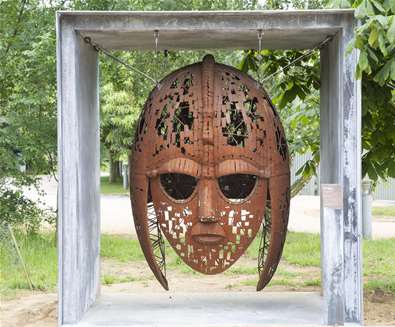
Anglo-Saxon Treasure at Sutton Hoo
Sutton Hoo is England's Valley of the Kings, and the Anglo-Saxon ship burial found in the King's Mound is the richest burial ever found in northern Europe. 1,400 years ago, a king or great warrior of East Anglia was laid to rest in a 90ft ship, surrounded by his extraordinary treasures. The discovery revolutionised our understanding of the Anglo-Saxon period and provided a lens through which to examine this fascinating era of history.
The most likely candidate for the man who belonged to this grave is King Rædwald, a great King of East Anglia who won both renown, for his victory over the Kingdom of Northumbria, and criticism, for establishing an altar for Christ and an altar for the old gods side by side.
You can pay a visit to this fascinating site, which is also the subject of the Netflix film 'The Dig' and discover The Suffolk Coast's fascinating past at National Trust Sutton Hoo.
Bungay 'Black Shuck'
Believed by many to be the inspiration for the titular hound in the famous Sherlock Holmes story ‘The Hound of the Baskervilles’, the legend of Black Shuck (also known as ‘The Bungay Black Dog) is infamous in the region.
According to folklore the creature has haunted the Bungay and Blythburgh heaths and coastline for centuries. The first mention of the demonic black dog was in 1577, in records that detail how the giant canine burst in through the doors of St Mary’s church in Bungay wrecking havoc and killing a man and a boy. It is said that after this, Black Shuck made its way to Blythburgh Church to maul other unfortunate souls.
If you’re unsure what to believe, pay a visit to Blythburgh Church where you can still see the scorch marks on the door, supposedly evidence of the hellhound’s giant claws.
The 'Wildman' of Orford
The small coastal village of Orford is the location of the rather bizarre tale of a man who came from the sea. The story goes that twelfth century fishermen felt a great weight in their nets one day and when they eventually dragged them from the sea they were alarmed to find a hairy, naked and bedraggled man. He was mute, making only grunts and cries and had no knowledge of the bible or the land.
The fishermen took the Wildman to Orford castle where he was imprisoned and fed a diet of raw fish. Whilst some thought he could be the ghost of a drowned sailor, many speculated that he was a merman, and indeed, when taken to swim in the water, he escaped under the surface, never to be seen again.
If you go to the Church of St Bartholomew in Orford today, you can still see a small stone Wildman at the base of the font.
Dunwich 'Atlantis'
The coastal village of Dunwich has been exposed to a large degree of coastal erosion throughout the years, which has resulted in what was once a large city with a population of 4000, diminishing as much of it crumbled into the sea- leading to the village being dubbed ‘Britain’s Atlantis’.
Towards the end of the 1300’s particularly ferocious storms wiped out around 400 homes and two churches, and it is said that on stormy nights the frantic ringing of church bells can be heard emanating from the waves.